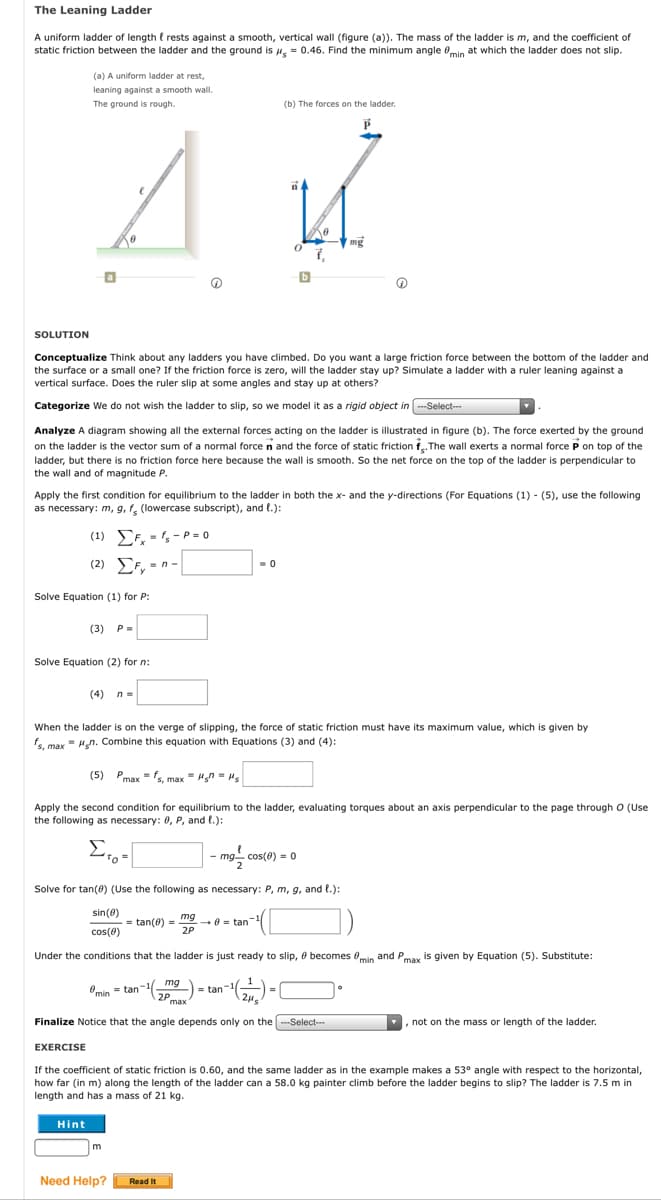A uniform ladder of length f rests against a smooth, vertical wall (figure (a)). The mass of the ladder is m, and the coefficient of static friction between the ladder and the ground is = 0.46. Find the minimum angle emin at which the ladder does not slip.
A uniform ladder of length f rests against a smooth, vertical wall (figure (a)). The mass of the ladder is m, and the coefficient of static friction between the ladder and the ground is = 0.46. Find the minimum angle emin at which the ladder does not slip.
Mechanics of Materials (MindTap Course List)
9th Edition
ISBN:9781337093347
Author:Barry J. Goodno, James M. Gere
Publisher:Barry J. Goodno, James M. Gere
Chapter2: Axially Loaded Members
Section: Chapter Questions
Problem 2.8.6P
Related questions
Question

Transcribed Image Text:The Leaning Ladder
A uniform ladder of length { rests against a smooth, vertical wall (figure (a)). The mass of the ladder is m, and the coefficient of
static friction between the ladder and the ground is H = 0.46. Find the minimum angle 0min at which the ladder does not slip.
(a) A uniform ladder at rest,
leaning against a smooth wall.
The ground is rough.
(b) The forces on the ladder.
mg
SOLUTION
Conceptualize Think about any ladders you have climbed. Do you want a large friction force between the bottom of the ladder and
the surface or a small one? If the friction force is zero, will the ladder stay up? Simulate a ladder with a ruler leaning against a
vertical surface. Does the ruler slip at some angles and stay up at others?
Categorize We do not wish the ladder to slip, so we model it as a rigid object in -Select--
Analyze A diagram showing all the external forces acting on the ladder is illustrated in figure (b). The force exerted by the ground
on the ladder is the vector sum of a normal force n and the force of static friction f..The wall exerts a normal force P on top of the
ladder, but there is no friction force here because the wall is smooth. So the net force on the top of the ladder is perpendicular to
the wall and of magnitude P.
Apply the first condition for equilibrium to the ladder in both the x- and the y-directions (For Equations (1) - (5), use the following
as necessary: m, g, f, (lowercase subscript), and l.):
(1) E, - - P = 0
(2) F, - n -
Solve Equation (1) for P:
(3) P-
Solve Equation (2) for n:
(4) n-
When the ladder is on the verge of slipping, the force of static friction must have its maximum value, which is given by
fs, max = Hn. Combine this equation with Equations (3) and (4):
(5) Pmax = fs, max = Hgn = Hs
Apply the second condition for equilibrium to the ladder, evaluating torques about an axis perpendicular to the page through O (Use
the following as necessary: 0, P, and f.):
- mg cos(0) = 0
2
Solve for tan(@) (Use the following as necessary: P, m, g, and e.):
sin(0)
= tan(0) =
mg
+ 0 = tan
2P
cos(e)
Under the conditions that the ladder is just ready to slip, e becomes emin
and Pmax is given by Equation (5). Substitute:
Omin = tan-1(-ng = tan
=
max
Finalize Notice that the angle depends only on the -Select--
not on the mass or length of the ladder.
EXERCISE
If the coefficient of static friction is 0.60, and the same ladder as in the example makes a 53° angle with respect to the horizontal,
how far (in m) along the length of the ladder can a 58.0 kg painter climb before the ladder begins to slip? The ladder is 7.5 m in
length and has a mass of 21 kg.
Hint
m
Need Help?
Read It
Expert Solution
This question has been solved!
Explore an expertly crafted, step-by-step solution for a thorough understanding of key concepts.
Step by step
Solved in 2 steps with 1 images

Knowledge Booster
Learn more about
Need a deep-dive on the concept behind this application? Look no further. Learn more about this topic, mechanical-engineering and related others by exploring similar questions and additional content below.Recommended textbooks for you

Mechanics of Materials (MindTap Course List)
Mechanical Engineering
ISBN:
9781337093347
Author:
Barry J. Goodno, James M. Gere
Publisher:
Cengage Learning

Mechanics of Materials (MindTap Course List)
Mechanical Engineering
ISBN:
9781337093347
Author:
Barry J. Goodno, James M. Gere
Publisher:
Cengage Learning